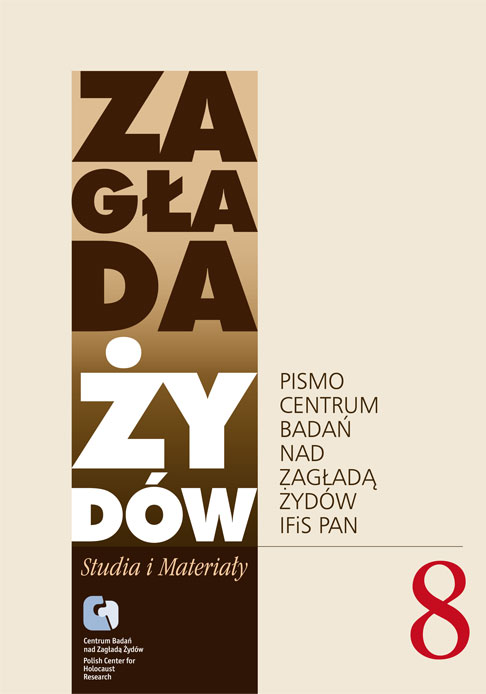On the Clearing of the Post-Camp World. Ways of Handling the Human Remains at the Former KL Auschwitz-Birkenau Camp from the Final Evacuation to the
Zagłada Żydów. Studia i Materiały, No. 8 (2012), Pages: 145-175
Submission Date: 2020-10-28Publication Date: 2012-12-02
 https://doi.org/10.32927/ZZSiM.630
https://doi.org/10.32927/ZZSiM.630
Abstract
This article attempts to reconstruct the ways in which the living handled the human remains at KL Auschwitz-Birkenau from the final evacuation until the establishment of the museum. The first part of the text describes the appearance of the camp after the Germans had abandoned it leaving the bodies, bones and human ashes. It then reconstructs the following actions: collection of the corpses, removal of the dead from the hospital, inspection of the places where the human ashes were, autopsies, religious ceremonies undertaken by the former prisoners, Polish Red Cross volunteers, medical personnel, etc. The text shows that those actions resulted in a creation of a new post-camp order administered by the Polish and Soviet authorities, initially represented by the military men, the Polish Society of Former Political Prisoners (Polski Związek Byłych Więźniów Politycznych) and the Catholic Church. The last part of the article describes the way of handling the corpses which developed in opposition to the official practice. That alternative order was developed by those who looked for valuables in the former camp where the human remains were.
License
Copyright (c) 2012 Author & "Holocaust Studies and Materials"

This work is licensed under a Creative Commons Attribution 4.0 International License.
https://creativecommons.org/licenses/by/4.0
Most read articles by the same author(s)
- Marta Zawodna , Shlomo Venezia, Sonderkommando. W piekle komór gazowych, przeł. Krystyna Szeżyńska-Maćkowiak, Prószyński i S-ka, przy współpracy z Państwowym Muzeum Auschwitz-Birkenau, Warszawa 2009 , Zagłada Żydów. Studia i Materiały: No. 6 (2010)
Similar Articles
- Piotr Trojański, “We need to send him one, because he is a ‘goldsmith’ or ‘Canada man’.” Case of an Oświęcim Camp Security guard , Zagłada Żydów. Studia i Materiały: No. 11 (2015)
- Caroline Sturdy Colls, Gone but not forgotten: Archaeological Approaches to the Site of the Former Treblinka Extermination Camp in Poland , Zagłada Żydów. Studia i Materiały: No. 8 (2012)
- Stefan Marcinkiewicz, Sammellager Bogusze (November 2, 1942 – January 3, 1943) as an example of a transitional collective camp in the Operation “Reinhardt” in the Bialystok District , Zagłada Żydów. Studia i Materiały: No. 20 (2024)
- Heléna Huhák, András Szécsényi, Cavalcade of Interpretations: The Kasztner train Through the Self-narratives of the Fugitives , Zagłada Żydów. Studia i Materiały: No. 18 (2022)
- Michał Kowalski, Treblinka Penal Labor Camp I as Presented in Jewish Testimonies , Zagłada Żydów. Studia i Materiały: No. 18 (2022)
- , Gone but not Forgotten: Archaeological approaches to the site of the former Treblinka Extermination Camp in Poland , Zagłada Żydów. Studia i Materiały: No. Holocaust Studies and Materials (2013)
- Bartłomiej Grzanka, Reports on an on-site inspection of the former camp area at Chełmno and the Rzuchów forest on 1 April 1945 by representatives of the Turek county authorities , Zagłada Żydów. Studia i Materiały: No. 19 (2023)
- Marian Turski, “Więcej nic nie powiem…” [I won’t say more...] - interview with Marian Turski, a Łódź ghetto survivor of 28 August 2019 on the eve of celebrations of the anniversary of Łódź ghetto liquidation , Zagłada Żydów. Studia i Materiały: No. 16 (2020)
- Monika Adamczyk-Garbowska, Three Visits to Auschwitz , Zagłada Żydów. Studia i Materiały: No. 14 (2018)
- Tadeusz Bartoś, Invariable Right to Great Death. Otto Kulka, Landscapes of the Metropolis of Death. Commentary , Zagłada Żydów. Studia i Materiały: No. 10 (2014)
1 2 3 4 5 6 7 8 9 10 11 12 13 14 15 16 17 > >>
You may also start an advanced similarity search for this article.
 English
English
 Język Polski
Język Polski



 https://orcid.org/0000-0002-0581-7197
https://orcid.org/0000-0002-0581-7197





